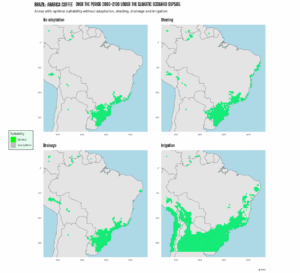Paris, June 10th – Climate change is significantly altering the global landscape for food production, with many of the world’s most important crops facing a sharp decline in suitable growing areas. A new study led by researchers at finres warns that for key crops like coffee, wheat, and beans, the fraction of land with optimal growing conditions has already peaked or is about to start falling. Without urgent adaptation measures, this may lead to significant disruptions to food security and global trade.
A new approach to measuring climate suitability
The study, titled “Have crops already reached peak suitability: assessing global climatic suitability decreases for crop cultivation”, introduces a new approach for assessing optimal climate suitability for agricultural products. The study outlines the methodology and key findings of data commissioned by the United Nations agencies IFAD and FAO, with the support of the French development agency (AFD). The peer-reviewed research is being published in the prestigious scientific journal Environmental Research Letters .
Researchers from finres looked at nine staple and cash crops: arabica coffee, cassava, common beans, common wheat, maize, plantain, rice, sorghum, and sugarcane. These crops provide more than half of the world’s calorie intake. Their results show a concerning trend: in five out of these nine crops, areas of optimal suitability are already shrinking. Coffee, beans, cassava, wheat, and plantain face highly significant losses of suitable land, and some crops’ optimum growing areas may be halved by the end of the century.
Declining crop suitability threatens over half of global calorie supply
The study finds that five out of nine major staple and cash crops—including wheat, coffee, beans, cassava, and plantain—are already losing optimal growing conditions, with some projected to lose half their optimal suitable land by 2100. Without urgent adaptation measures, millions of people could face increased food prices, trade disruption, and heightened risk of food insecurity.

The study highlights regional disparities in climate impact, with tropical and subtropical regions suffering the most. Suitability for key crops declines in 30% of currently cultivated lands, whereas gains in other regions compensate for only 19% of losses.
- Coffee production, a vital industry for many tropical economies, is particularly vulnerable. Suitability in major coffee-growing regions like Brazil, Vietnam, and Indonesia is expected to decline sharply by 2100.
- Beans and wheat will also see significant losses, especially in mid-latitude regions such as North America and Europe.
- Maize and rice may temporarily benefit from expanded suitable areas, but this advantage is projected to reverse by the end of the century, particularly under high-emission scenarios.
Changes threaten the food sovereignty of developing countries whose staple crops, forming the backbone of local diets, will include cassava, plantain, and beans. Unless effective adaptation occurs, more countries will start relying more on imports of food products, placing them at risk from price spikes and disruptions in food supply chains.
Adaptation strategies: The key to mitigating crop suitability loss
Considering the rapid loss of arable land, therefore, the researchers highlighted the urgent value of adaptation strategies:
- Relocation or expansion of production areas – while the shift of crop production to more favorable climates is one strategy, this option is limited by land availability, different jurisdictional requirements, and other land-use claims. In most instances, the areas that may become potential farmlands, for instance boreal regions, are forested and hence would create additional problems related to deforestation and loss of biodiversity.
- Implementation of climate adaptation techniques – the study finds that certain adaptation measures, like irrigation, drainage, and shading, could significantly mitigate climate-driven suitability losses.
- Irrigation could increase the fraction of land with optimal suitability from 5-25% to nearly 50%, particularly for maize, beans, coffee, and rice.
- Drainage systems could improve the suitability of maize and sorghum fivefold, helping to offset losses due to excess precipitation.
- Shading techniques, like agroforestry, could boost coffee suitability by up to 20%, helping to preserve its cultivation in regions where temperatures are rising beyond optimal levels.
- Agricultural efficiency and climate resilience can also be improved through precision agriculture, improved soil management, and heat-tolerant crop varieties that can realize yields as suitability declines.
“If adaptation measures are not implemented, the loss of suitable farmland could lead to major disruptions in food production and trade”, said Florent Baarsch, finres CEO and Founder and co-author of the study, “This could trigger price spikes, supply shortages, and even increased deforestation as farmers seek new land.”
Implications for global food security and policy
The loss of agricultural suitability is both an environmental and socioeconomic issue, affecting developing nations that rely on agriculture. Disruptions in crop production could cause economic instability, with crops like coffee and beans facing decreased suitability, potentially altering global trade.
The study calls for urgent policy action at national and international levels: prioritizing agricultural adaptation, fostering international cooperation to avoid food shortages, and encouraging diversified sourcing strategies. Stronger climate action is essential to prevent further damage, as adaptation alone cannot replace reducing greenhouse gas emissions to protect livelihoods.
A call for urgent action
The study gives very strong evidence that climate change is already reshaping agriculture across the world and that suitability of many of the most productive regions is declining. Without action, farmers, consumers, and economies will be exposed to an increased risk of food insecurity and economic disruption.
The findings emphasize the importance of adaptation measures. Resilient farming, sustainable management of water resources, and climate-smart policies will be key to protect agriculture from the changes to climate already underway.
Notes to editors
Unlike traditional models that rely solely on temperature and precipitation, this study incorporates water balance calculations. This approach provides a more accurate assessment of how climate change impacts agricultural productivity.
The complete study, Have crops already reached peak suitability: assessing global climatic suitability decreases for crop cultivation, including the full methodology, climate scenarios modelled and other details is available here.
For media enquiries, please contact:
- Wassim Yahyaoui: wassim.yahyaoui@finres.dev